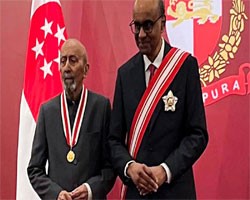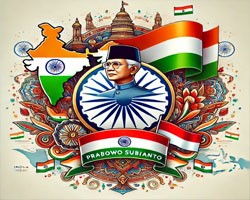SSC Current Affairs
TABLE OF CONTENTS |
| International Relations |
|---|
|
|
|
Why in the News?
India and Spain have designated 2026 as a ‘Dual Year’ to promote collaborations in culture, tourism, and artificial intelligence (AI). External Affairs Minister S.Jaishankar announced this initiative to strengthen bilateral ties through cultural and technological partnerships. Key Takeaways Cultural Exchange The ‘Dual Year’ will feature cultural programs like art exhibitions, music and dance performances, literature festivals, and architectural collaborations. Events will showcase the rich cultural heritages of both nations. Tourism Promotion Focus on promoting tourism through reciprocal visits, direct flight connections, and joint marketing campaigns. Hosting of tourism fairs and showcasing of popular destinations to attract visitors. Artificial Intelligence Collaboration Collaborative efforts in AI research, development, and implementation across healthcare, education, and industry sectors. Includes joint workshops, seminars, and establishment of AI research centers. Bilateral Trade and Economic Cooperation India and Spain share an annual trade volume of USD 10 billion in sectors like railways, clean technology, drones, and space exploration. The ‘Dual Year’ aims to enhance economic relations further. Role of the Indian Diaspora The Indian diaspora in Spain plays a key role in fostering bilateral ties, contributing to Spain’s economy and goodwill. Preparations for 2026 Joint committees, funding arrangements, and coordination between cultural and tourism departments are in progress to ensure the success of the ‘Dual Year’ celebrations. |
| National |
|
|
|
Why in the News?
On January 14, 2025, the Government of India, through the Ministry of Education, launched the APAAR ID initiative, also known as the “One Nation One Student ID Card” program. This ambitious initiative aims to streamline and digitize the academic records of students across India by providing a centralized, permanent academic identity. Key Takeaways About APAAR ID: Full Form: Automated Permanent Academic Account Registry. Acts as a digital academic identity card, integrating details like degrees, scholarships, credits, and rewards. Functions through the Academic Bank of Credits (ABC Bank), introduced under the National Education Policy (NEP). Objectives of APAAR ID: Centralized Academic Records: Collect and store academic data and credits in a single digital platform. Unique Student Identity: Provides a 12-digit unique APAAR number to each student, ensuring organized academic tracking. Promotes the concept of EduLocker, a digital storage space for academic credentials. Benefits of APAAR ID: Streamlined Processes: Simplifies academic credit transfer between institutions. Digital Access: Provides easy access to scholarships, rewards, and academic certifications. Inclusive Coverage: Available for students from both private and government schools/colleges. Enhances accountability and transparency in the education system. How to Register for APAAR ID: Students can register through the official portal: abc.gov.in. Requires basic details like mobile number, Aadhar card number, school/university details, and academic qualifications. Post-registration, the APAAR ID card is generated with a QR code for verification. ABC Bank and Digilocker Integration: The Academic Bank of Credits (ABC Bank) supports the issuance and management of APAAR IDs. Students can register and access their APAAR Card through the Digilocker platform, ensuring secure and easy storage. Adoption and Reach: Currently, thousands of institutes and over 2 crore students have registered for the APAAR ID, highlighting its widespread acceptance. Aims to make academic data universally accessible and secure. Significance: The APAAR ID initiative is a transformative step in India’s education system, aligning with the goals of the National Education Policy (NEP). By centralizing academic records and providing a unique identity to every student, the initiative not only simplifies academic processes but also fosters transparency and efficiency in the education sector. This digital revolution promises to enhance the academic journey for millions of Indian students. |
|
|
|
Why in the news?
The Union government announced the constitution of the 8th Pay Commission on the 16th of January 2025. Aim: A Pay Commission, set up by the government of India, decides the salary and compensation of Central government staffers and allowances of pensioners. The 8th Pay Commission will recommend revisions in the salary and pension structure of the beneficiaries, resulting in a hike in the remuneration and allowances. Key Points: The implementation of the pay commission’s recommendations results in increased consumption and economic growth, with an improved quality of life for government employees. Generally, every 10 years, the central government implements a pay commission to revise employee remuneration. There is no obligation on the government to accept the recommendations of the pay commission. Since 1947, seven Pay Commissions have been constituted, with the last one constituted in 2014 and implemented on January 1, 2016. The chairman of the 7th Pay Commission is Justice Ashok Kumar Mathur. It’s tenure will end in 2026. 1st Pay Commission (1946): Implementation Year: 1947 Key Features: Focused on improving living standards for employees. Minimum salary was fixed at Rs 55 per month. Emphasis on equitable pay structure. Ratio of the highest salary to the minimum salary was 1:41. Impact: Although the recommendations addressed post-independence challenges, they highlighted the need for a better salary structure for lower-income groups. 2nd Pay Commission (1957): Implementation Year: 1959 Key Features: Minimum salary raised to Rs 80 per month. Focus on reducing disparities in wages. Recommended provisions for family allowances and retirement benefits. Impact: The changes improved financial security for employees, reflecting the growing economic challenges of the 1950s. 3rd Pay Commission (1970): Implementation Year: 1973 Key Features: Minimum salary increased to Rs 185 per month. Addressed cost of living by introducing dearness allowance (DA) as a relief measure against inflation. Focused on pay parity between various groups of employees. Impact: Introduction of DA was a game-changer, ensuring that employees’ salaries were adjusted in line with inflation rates. 4th Pay Commission (1983): Implementation Year: 1986 Key Features: Minimum salary increased to Rs 750 per month. First attempt at comprehensively restructuring pay scales. Recommendations for increasing housing and travel allowances. Impact: The substantial pay hike addressed inflation and improved employee satisfaction. However, the implementation was criticized for delays. 5th Pay Commission (1994): Implementation Year: 1997 Key Features: Minimum salary raised to Rs 2,550 per month. Recommended merging 50% of DA with basic pay for better financial stability. Focused on employee welfare schemes. Impact: A significant increase in salaries improved the purchasing power of employees. However, the recommendations led to increased financial strain on the government. 6th Pay Commission (2006): Implementation Year: 2008 Key Features: Minimum salary increased to Rs 7,000 per month. Introduction of Pay Band and Grade Pay system for streamlining salary structures. Emphasis on performance-based incentives. Impact: The introduction of the Pay Band system simplified salary structures and provided clarity on career progression. Despite criticism of delayed implementation, it was largely seen as employee-friendly. 7th Pay Commission (2013): Implementation Year: 2016 Key Features: Minimum salary raised to Rs 18,000 per month. Removal of Pay Band and Grade Pay system, replaced by Pay Matrix. DA rates to be revised biannually. Recommendations for improving pension benefits. |
| Economy |
|
|
|
Why in the News?
India is projected to surpass Japan as the world’s fourth-largest economy by 2026, according to the PHD Chamber of Commerce and Industry (PHDCCI). This milestone is driven by robust GDP growth, strategic policy reforms, and sectoral advancements. Key Takeaways Projected GDP Growth India’s GDP is expected to grow by 6.8% in FY2024-25 and 7.7% in FY2025-26, helping it elevate its global economic position. Currently the 5th largest economy (2023), India is set to move to 4th place, surpassing Japan by 2026. Proposed Tax Reforms Increase the income tax exemption limit to ₹10 lakh. Apply the peak tax rate of 30% for incomes above ₹40 lakh, compared to the current threshold of ₹15 lakh. Reduce tax rates for partnerships, LLPs, and proprietorships from 33% to 25%, promoting business growth and increasing disposable incomes. Monetary Policy Outlook With CPI inflation projected to decline to 2.5%-4%, the Reserve Bank of India (RBI) is expected to lower the benchmark interest rate by 25 basis points, reducing borrowing costs and fostering growth. Growth-Driving Sectors Focus areas include agriculture and food processing, fintech, semiconductors, renewable energy, health, and insurance. Emphasis on sustainable development to attract global investments and ensure long-term economic progress. Five-Pronged Growth Strategy Increase Capital Expenditure: Investments in infrastructure and public projects to stimulate the economy. Ease of Doing Business: Simplify regulatory frameworks to attract investments. Reduce Business Costs: Implement strategies to lower operational costs. Promote Labour-Intensive Manufacturing: Drive job creation through manufacturing sectors. Boost Global Trade Integration: Strengthen global value chain participation to enhance exports. Static International Fact: Japan Capital: Tokyo Prime Minister: Shigeru Ishiba Currency: Japanese Yen (JPY) |
| Awards |
|
|
|
Why in the news?
On January 15, 2025, Singapore conferred its prestigious Honorary Citizen Award on Tarun Das, the former Director General of the Confederation of Indian Industry (CII), in recognition of his outstanding contributions to strengthening the relationship between Singapore and India. The award was presented by President Tharman Shanmugaratnam in New Delhi. Key Takeaways A Legacy of Strengthening Bilateral Ties Tarun Das has been a key figure in the development of Singapore-India relations for over three decades. His significant work began in 1993 when he led a delegation of Indian industrialists to Singapore, aligning with India’s “Look East” policy. This initiative laid the foundation for deepened economic ties between the two nations, fostering continuous high-level exchanges and collaborations. Pioneering Dialogues and Exchanges Das’s contributions extend beyond economic ties. He was instrumental in establishing the India-Singapore Strategic Dialogue, a vital platform for business leaders, policymakers, and academics from both countries. The 15th edition of this dialogue took place in August 2024, underscoring its continued importance. Das also played a pivotal role in enhancing people-to-people connections through youth and academic exchanges, notably the inaugural Students Immersion Programme to India in 2023. Recognition of a Distinguished Career This award adds to the recognition Das has previously received for his efforts to bolster bilateral relations. In 2004, he was honored with the Singapore Public Service Medal. The Honorary Citizen Award, presented by Singapore’s President, is the highest honor conferred upon non-citizens, further acknowledging his invaluable contribution to the Singapore-India partnership. Tarun Das’s Reflection Upon receiving the Honorary Citizen Award, Tarun Das expressed deep gratitude, saying: "I am deeply honoured and privileged to be selected by the Singapore Government to receive the Honorary Citizen Award. My journey with Singapore started 31 years ago, and I have witnessed the ‘Singapore-India Fever,’ reflecting a multi-faceted partnership, evolve and grow over the years. A source of great happiness for me." |
| Persons in News |
|
|
|
Indonesian President Prabowo Subianto will be the chief guest of India’s 76th Republic Day celebrations on January 26.
While this will be President Prabowo’s first visit to India in his capacity as president after assuming office in October 2024, this is the fourth time that an Indonesian leader has been invited as the chief guest at the Republic Day celebrations. |
|
<< 16-Jan-25
|
|
|





